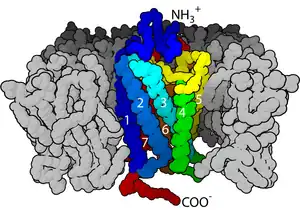細胞表面受體
細胞表面受體(cell surface receptor),是一類位於細胞表面的受體。細胞表面受體可以接收來自細胞外的信號,即與可以配對的配體結合,引發細胞內部的反應,最後產生特定的效應。這個效應可能僅在短時間內持續,比如細胞代謝或運動上的改變。也可能是長時間持續的,比如說使特定基因的表達上調[1][2]。總的來說,已發現的較經典細胞表面受體包括:G蛋白偶聯受體(G protein-coupled receptor)、受體酪氨酸激酶(Receptor tyrosine kinases)、鳥苷酸環化酶偶聯受體(Guanylate cyclase-coupled receptor)、離子通道(ion channel),以及黏附受體(adhesion receptor),其中以G蛋白偶連受體的數量最多[1][3]。

一種G蛋白偶聯受體的結構示意圖,圖中用彩色標出的是其七次穿膜的結構
參見
- 核受體
- 配體
參考
This article is issued from Wikipedia. The text is licensed under Creative Commons - Attribution - Sharealike. Additional terms may apply for the media files.